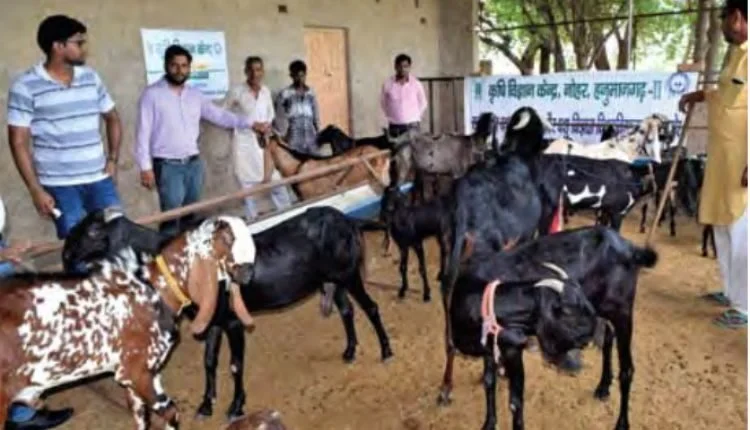How to choose advanced breed in goat farming?
Do you know these very important things related to goat farming? Know the important things related to Goat Farming business
Goat milk is considered very nutritious. Goat’s milk is given to malnourished children and is also used in the production of many medicines. Goat milk is also a good source of calcium. But there is a need to develop the goat milk market on a larger scale so that it can reach more people and the goat farmers get more profit. Apart from milk, goat meat is also in great demand. Not only this, many things like blankets, kalija, sacks are also made by mixing goat’s hair with sheep’s thick fiber wool. That is, if goat farming is developed as a small scale industry, it can provide employment to many people in rural areas.
Breed of goat
If you are going to start goat farming business, then first of all you should have complete knowledge about their breed. According to ICAR, if you want to rear goats for the purpose of both milk and meat, then buy goats of Jamunapari, Barbari, Beetal, Surti, Jakharana breeds. If you want to rear goats only for meat, then Black Bengal, Ganjam, Osmanabadi, Sangamneri and Sirohi breeds of goats are considered good. If you are doing goat rearing for fibre production, then buy Marwari, Gaddi, Chengu, Changthangi breed.

Characteristics of different breeds of goat
Jamunapari- Found in Agra and Etawah areas of Uttar Pradesh, this goat breed is reared for both milk and meat. Male weighs 50-60 kg and female weighs 40-50 kg. It is usually white in color and has dark brown spots on the body.
Black Bengal – The size of this goat found in West Bengal and Assam is small. The colour is black/brown, the horns are raised upwards and the chest is broad. The male weighs up to 30 kg and the female weighs up to 20 kg.
Barbari- This breed is mainly found in Rajasthan and Uttar Pradesh. Its weight is up to 40 kg. It has small size, small ears and small horns. Its colour is white and brown.
Beetle- This breed of Punjab and Haryana is of large size. Their colour is brown, ears are long and horns are bent backwards. The weight of the male is 50-60 and the weight of the female is up to 40-50 kg.
Sirohi- Sirohi and Ajmer district of Rajasthan is its place of origin. Male weighs 40-50 kg and female weighs 30-40 kg.

Things to keep in mind in goat farming:
- Before starting the business, collect complete information about the breed of goat and the product obtained from it.
- If someone wants to do goat rearing in Rajasthan, then the Marwari breed goat is the best for him. Because leather, milk and hair are obtained from it.
- Goats should be given a balanced diet. This increases weight and milk production.
- Goats should be fed clean water, so that they stay away from diseases.
- Female goats should be impregnated with goats of advanced breed only.
- In the beginning too many goats should not be bought. Place goats in the slots of ten each. Proper care is not possible if more goats are kept together.
- Sick goats should be separated. Along with this, it is necessary to identify the diseases of goats and treat them at the right time.
- Vaccination of goats is also necessary to protect them from the disease.

Give nutritious fodder to goats
- Balanced diet, be clean and digestive. Don’t change the feed completely.
- Straw, green fodder and grains should be included in the diet. Give well prepared fodder and feed twice a day (munching, soaking, boiling, etc.)
- Give separate ration to pregnant goats and milking goats.
- Goats should be given 2-2.5 kg dry matter per kg body weight.
- Give 1/3 part green fodder and 2/3 part dry fodder
- Goats should start complementary feeding from one month before their calving period, so that the body weight increases.
Vaccination in goats
| Probable Month | Disease | Primary Immunization | Routine Immunization |
| January | Contagious canine pleuro pneumonia (CCPP) | at 3 months of age | annually |
| February | Flare-up | at 4 months of age | annually |
| February | PPR | at 3 months of age | Once every three years |
| July | Galghontu | at 6 months of age | annually |
| March to October | Foot and mouth | for 4-5 months and thereafter | twice a year (March and October) |
| December | Goat pox | at 3 months of age | annually |
Also Read: Why Osmanabadi Goat is considered better for meat production?
Contact us – If farmers want to share any valuable information or experiences related to farming, they can connect with us via phone or whatsapp at 9599273766 or you can write to us at “[email protected]”. Through Kisan of India, we will convey your message to the people, because we believe that if the farmers are advanced then the country is happy.
You can connect with Kisan of India on Facebook, Twitter, and Whatsapp and Subscribe to our YouTube channel.



